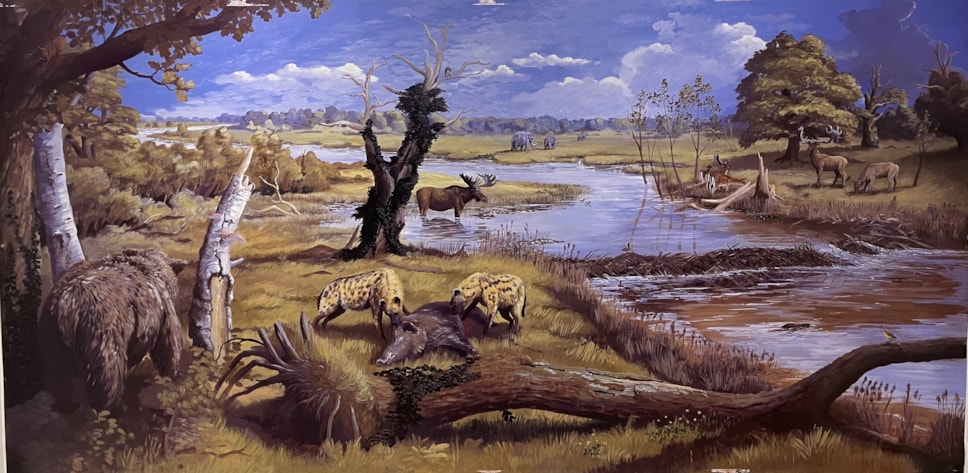
Step back in time at Hackney Museum with ‘Hackney 300,000 BC’
Hackney Museum is inviting residents to step back in time with its new temporary exhibition ‘Hackney 300,000 BC: Meet the Neanderthal neighbours and curious creatures of the borough's Old Stone Age’.
The exhibition, supported by The Royal Society and The National Lottery Heritage Fund, provides a rare glimpse into pre-historic Hackney when the borough resembled a south African savannah, with hippos, lions and mammoths roaming the landscape, and where a now extinct people, the Neanderthals, lived. Stone artefacts displayed in the exhibition are so ancient, they predate the existence of modern humans (Homo sapiens) by a hundred thousand years.
With pre-history now a part of the school national curriculum for 7 to 9 years old, the exhibition was informed by input and feedback from teachers at schools across the borough. A special preview of the exhibition was organised for some of the schools last week, during which over 200 students had an opportunity to learn about life in the Stone Age through watching toolmaking demonstrations, creating artworks, and meeting with archaeologists.
Hackney is one of Britain's most important archaeological sites from the Old Stone Age (Palaeolithic) with over 3,000 ancient objects uncovered and preserved in the borough since the late 19th century. Visitors will find out more about Hackney in the Stone Age and handle some of the real artefacts.
Included in the exhibition, you will learn about:
The largest ever land mammal
Sewer works in 1960 on Evering Road, next to Rectory Road station, discovered the huge teeth and a skull fragment of a straight-tusked elephant. Straight-tusked elephants may have been the largest land mammal to have ever existed. They could weigh over 14 tonnes and reach up to 4.5 metres tall, making today’s modern elephants seem small in comparison. The straight-tusked elephant became extinct in Britain about 115,000 years ago.
The handaxe
Wrongly thought of as less intelligent, Neanderthals are often shown using unshaped rocks or wooden clubs, of which there is no archaeological evidence. The stone tools discovered in Hackney show us that they in fact were highly skilled tool makers.
Handaxes found in Hackney were the Old Stone Age version of the Swiss Army knife. By studying marks left on the surface of stone axes, archaeologists can tell they had multiple uses, including butchering and skinning animals, cutting wood and even digging.
Handaxes suggest that the toolmakers of the Old Stone Age had an appreciation of design and ‘beauty’. Handaxes often show far more skill, symmetry and size than needed for them to simply be a useful tool. In some cases, handaxes are so large that they would be impractical to use at all. Some archaeologists have proposed that handaxes were a way of showing off the maker’s knowledge and skill for status - or maybe even to attract a member of the opposite sex.
The archaeological pioneer
Worthington George Smith (1835-1917) was an eccentric architect and artist from Shoreditch whose pioneering archaeological methods and dedicated research are still central to understanding the British Old Stone Age today.
Smith was interested to learn that ancient stone tools had been found in the housing developments just northeast of his home at 15 Mildmay Grove, Shoreditch. He began daily visits to personally examine the gravel pits, drainage ditches, house foundations and newly laid roads in search of artefacts.
His dedication preserved a priceless record of an extremely rare archaeological site that would otherwise have been lost without notice beneath London. He observed and identified the existence of buried ancient land-surfaces (his ‘Palaeolithic floor’) on which well preserved tools were left as they were hundreds of thousands of years before.
In 1880 he explored the construction sites north of Stoke Newington Common, and over the next four years found over 200 handaxes and ‘hundreds of thousands’ of flakes. He found so many that he offered them to other collectors for just the price of postage.
In his book Man the Primeval Savage (1894) he offered alongside his findings illustrations depicting life in the Old Stone Age. These included the images of women involved in activities such as toolmaking, which was progressive for the time.
Notes to editors
The exhibition is open until 22 July. For details about the exhibition and information about Hackney Museum visit: https://hackney-museum.hackney.gov.uk/
The exhibition is part of a wider project called ‘Reimagining Hackney Museum: Connecting Communities with Collections’ which has received initial support from The National Lottery Heritage Fund. For more information visit: https://hackney-museum.hackney.gov.uk/get-
involved/projects-and-partnerships/reimagining-hackney-museum/
About The National Lottery Heritage Fund
National Lottery Heritage Fund grant applications over £250,000 are assessed in two rounds. Reimagining Hackney Museum: Connecting Communities with Collections has initially been granted round one development funding of £266,782 by The National Lottery Heritage Fund, allowing it to progress with its plans. Detailed proposals are then considered by The National Lottery Heritage Fund at second round, where a final decision is made on the full funding award of £1,896,618.00.
Using money raised by the National Lottery, the fund inspires, leads and resources the UK’s heritage to create positive and lasting change for people and communities, now and in the future. www.heritagefund.org.uk
Follow @HeritageFundUK on Twitter, Facebook and Instagram and use #NationalLotteryHeritageFund
Since The National Lottery began in 1994, National Lottery players have raised over £46 billion for projects and more than 670,000 grants have been awarded across the UK - the equivalent of more than 240 lottery grants in every UK postcode district. More than £30 million raised each week goes to good causes across the UK.
About The Royal Society
The Royal Society is a fellowship of many of the world's most eminent scientists and is the oldest scientific academy in continuous existence. It has funded this project through its Places of Science grants scheme. For more information visit: https://royalsociety.org/grants-schemes-awards/grants/places-of-science/
Our teachers forum held last year provided some valuable insights into what children wanted to see and how best to present information to help them learn. A big thank you to our museum team who kept local schools involved throughout the project and worked together to ensure the exhibition was as informative and entertaining as it could be.
This reminds me of my time as a teacher looking for opportunities to bring learning alive! I cannot wait for our children and young people to step back in time to see all the ancient artefacts and find out about what Hackney was like in 300,000BC!
Cllr Anntoinette Bramble, Deputy Mayor and Cabinet Member for Education, Young People and Children's Social Care
This exhibition provides a truly fascinating glimpse into Hackney 300,000 years ago. Hackney is one of the richest sites for finding objects from that time period. It’s an incredible opportunity to see artefacts from hundreds of thousands of years ago. I hope residents join us in taking a trip back through time.
Cllr Chris Kennedy, Cabinet Member for Health, Adult Social Care, Leisure and Culture
